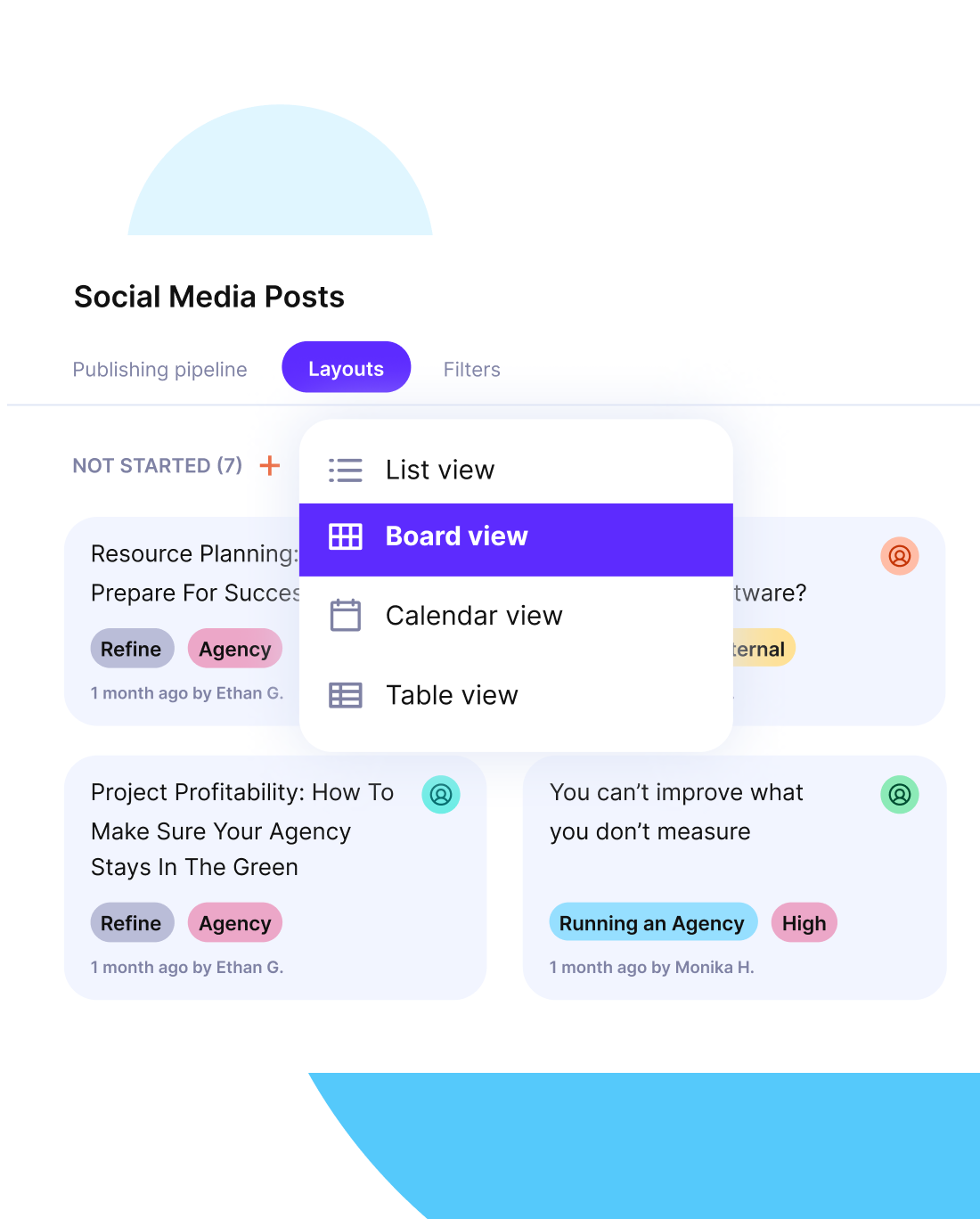What Is Resource Optimization: Techniques, Tools, Tips
A lot of companies have a hard time with resource optimization. It often manifests as wasted hours, overbooked teams, and missed opportunities for growth.
The good news is that improving how you plan and track resources is not that hard, and making even small improvements makes a noticeable difference. In this detailed guide, you’ll learn how to optimize resources, fix common roadblocks, apply proven techniques and best practices, and choose the right tools.
Key Takeaways
- Resource optimization is a key aspect of project management that aligns people, budgets, and tools so projects run smoother and finish with less wasted effort.
- Better alignment leads to higher team utilization, so people spend more time on valuable work instead of admin.
- Clearer planning improves forecasting, which helps you set realistic timelines and avoid last‑minute scrambles.
- With stronger visibility and fewer manual spreadsheets, you protect project profitability and make smarter decisions faster.
What Is Resource Optimization?
Resource optimization is the process of making sure people, budgets, and tools are used in the smartest way possible to maximize outcomes. It brings together resource allocation, capacity planning, and resource management to align work with business goals and eliminate waste.
Types of Resources to Optimize
The resource types you optimize are human, financial, and tools/technology. Each needs a different approach. Optimizing all three together helps reduce friction, cut waste, and improve overall efficiency.
A resource optimization cycle could look like this:
- Monday: Update your skills and availability board. If anyone exceeds an 80% workload for the next two weeks, reassign tasks or consider bringing in a contractor.
- Wednesday: Review budget versus actuals in your project management software. If the variance is over 5%, trim scope, adjust rates, or add capacity, and document the change.
- Friday: Check if the project lead is still using spreadsheets to track project timelines, working hours, or budgets. If you are, move that data into your main platform and phase out the extra files.
| Resource Type | What It Means | What to Optimize | Practical Example |
|---|---|---|---|
| Human | Your internal team members, contractors, and freelancers. | Project workflow bottlenecks, uneven workloads, or underused skills. | Reassign design tasks from an overloaded team member to a freelancer. |
| Financial | Project budgets, billing, and cash flow. | Budget control and margin protection. | Set budget thresholds and reduce scope if burn rate exceeds forecast. |
| Tools/Technology | Software, systems, and platforms used in daily work. | Overlapping tools, unused features, or manual duplication. | Replace separate resource scheduling and budgeting tools with an all-in-one platform. |
Why Is Resource Optimization Important?
Resource optimization is important because it helps you use your people, time, and budgets in a way that actually drives results.
When you plan and track work with more intention, you catch margin leaks early, gain better financial visibility, and spot capacity issues before they create delays. All of that directly impacts project profitability and sets the foundation for stronger capacity forecasting.
Let’s break down the specific impact areas where you can expect improvements when you get resource optimization right.
Impact on Profitability
A well-run resource optimization process gives you a clear picture of where budget overruns actually happen, such as overstaffed phases, scope creep, or duplicated work.
When you’re not tracking this closely, small misalignments go unnoticed until it’s too late to fix them.
That’s where tools with built-in financial visibility help: they let you catch these margin leaks early and reallocate work before profits take a hit. With Productive, teams often see improvements in project profitability by tying their resource plan directly to budgets and billable capacity.
Impact on Team Performance
When resource optimization is done well, your team spends less time reacting and more time executing. Instead of having some team members constantly overbooked while others sit idle, you can shift work based on availability and skill fit.
In Productive, you can visualize everyone’s availability in one view, making it easier to reassign or delay work before employee burnout becomes a problem.
Impact on Forecasting
Resource optimization improves capacity forecasting by giving you real-time visibility into who’s available, what’s booked, and where there are gaps in the upcoming weeks.
Instead of relying on static plans or guesswork, you can make staffing decisions based on actual workload data. In Productive, teams can forecast capacity with visual planning views that show upcoming workload across projects and roles, helping them plan with confidence.
Optimize resources with Productive
What Are the Benefits of Resource Optimization?
Resource optimization creates measurable improvements across your business when done right. Whether you’re trying to increase profit margins, reduce team stress, or deliver more value to clients, aligning your people and budgets with actual work needs makes a difference.
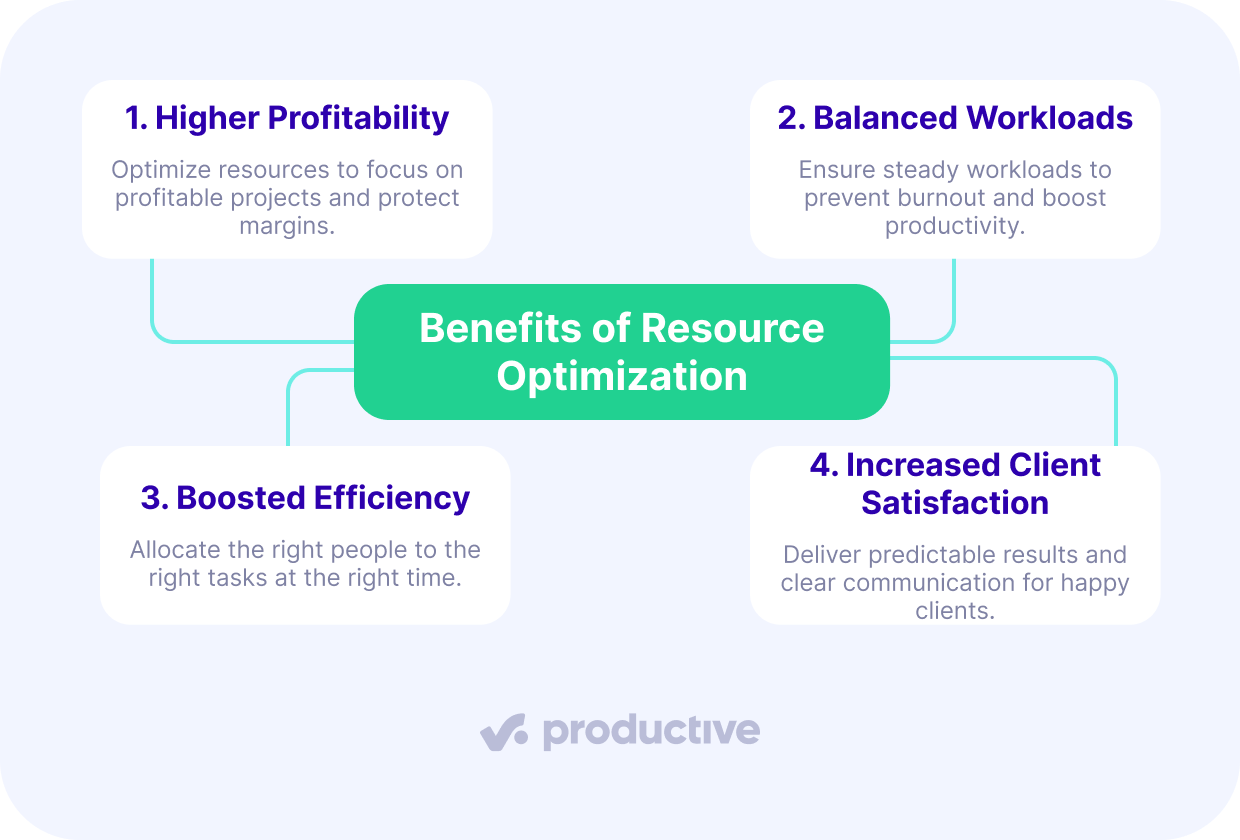
Let’s look at what those benefits actually look like in real life, before we get into the challenges that can hold teams back.
Higher Profitability
Resource optimization benefits project profitability because it prioritizes the right projects and allocates the right level of effort to each. When you know exactly how much capacity you have and where it’s going, you avoid over-servicing clients who aren’t profitable and protect margin on fixed-fee projects.
Balanced Workloads
Balanced workloads protect your team’s energy and output by making sure no one is routinely overbooked or left idle. When one person is buried in tasks and another is sitting idle, you lose time, reduce focus, and risk missing deadlines.
Smart resource allocation lets you shift tasks based on current workload and skill fit, so your team works at a steady, manageable pace. This kind of workload balancing prevents burnout, helps people focus, and keeps delivery predictable.

Instantly see who’s available and who’s overbooked.
Boosted Efficiency
Resource optimization increases operational efficiency because it helps teams eliminate unnecessary steps, reduce handoff delays, and fix planning mismatches before they cause churn.
When you use proper resource allocation, you make sure that the right people are working on the right things at the right time.
Increased Client Satisfaction
Client satisfaction improves when work is delivered predictably, communication is clear, and expectations are met without surprises. When your teams aren’t scrambling or switching gears constantly, they become more responsive and consistent.
Clients notice that kind of reliability.
For example, having a better grip on team capacity helps you say no to last-minute requests that would otherwise derail ongoing work. It’s easier to protect scope and project timelines when you know exactly what’s in progress and what’s coming next.
We talk a whole lot more about keeping and managing happy clients in our detailed client management guide.
What Are Resource Optimization Techniques?
Resource optimization techniques are structured methods like reverse resource allocation, resource leveling, and resource smoothing that help you balance workload and capacity.
Each technique addresses different resource scheduling challenges, and together they provide practical ways to keep projects on track. Let’s break them down one by one.
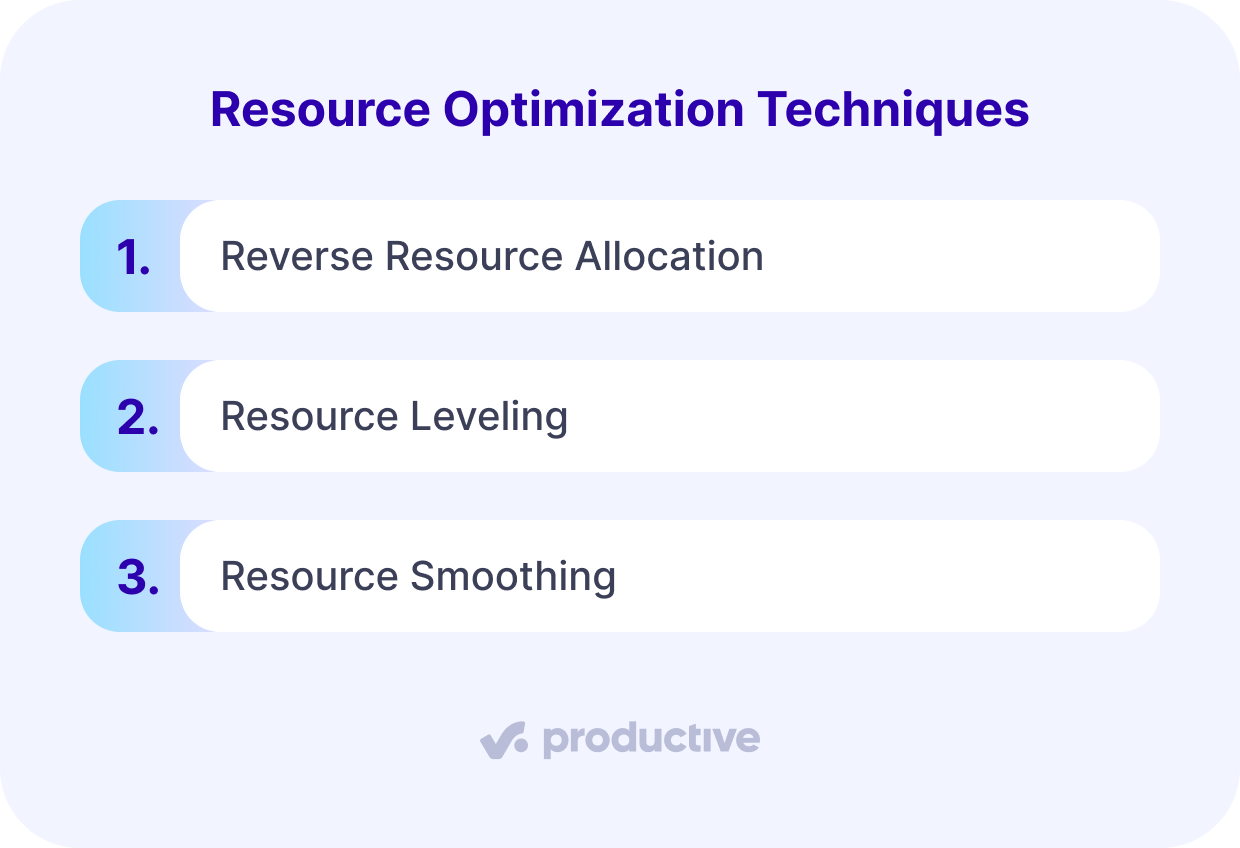
Reverse Resource Allocation
Reverse Resource Allocation flips the usual planning process by starting with fixed deadlines or budgets and then working backward to assign resources. This technique helps you see if you can realistically deliver with the people and hours you already have.
Example:
Imagine you have a client project due in four weeks with a tight budget. Instead of assigning tasks freely, you map the hours available within the budget and assign only the people who fit that limit. You quickly see if the timeline is realistic or if you need to renegotiate the scope.
How to perform Reverse Resource Allocation:
1. Define the fixed constraint (deadline or budget).
2. List the essential tasks and estimate hours for each.
3. Match tasks to available people without going over budget or time.
4. Adjust the scope or staffing if the plan doesn’t fit the constraint.
Resource Leveling
Resource Leveling spreads work more evenly by delaying or extending tasks to match actual resource availability. Instead of overloading your busiest people, you shift schedules so the workload fits the hours you have.
This technique works best when deadlines are flexible and quality matters more than speed.
Example:
A software project has two developers assigned, but both are already at 90% capacity. Resource leveling lets you extend certain tasks by a week and shift deadlines slightly so the same developers can handle the work without burning out.
How to perform Resource Leveling:
1. List all tasks with their deadlines and assigned resources.
2. Check workloads to see where people exceed realistic capacity.
3. Push or extend tasks that are less critical so workloads balance out.
4. Communicate changes to stakeholders to reset expectations.
Resource Smoothing
Resource Smoothing adjusts task timing within available slack (or float) to ensure resources are not overloaded while deadlines remain fixed. Unlike leveling, smoothing avoids extending the overall project timeline.
Example:
A marketing project has content writing due on Friday and design due the following Wednesday. The design team has some flexibility, so you can shift a few hours of writing into early next week without changing the final delivery date. This keeps workloads steady while meeting deadlines.
How to perform Resource Smoothing:
1. Review your project schedule and identify tasks with available float.
2. Check workloads to see where some people are stretched while others have room.
3. Reassign or move flexible tasks into the open slots without pushing project deadlines.
4. Monitor results weekly and adjust again if workloads become uneven.
What Are the Challenges of Resource Optimization + How To Solve Them?
The biggest challenges in resource optimization are unclear priorities, fragmented systems, manual workflows, and inconsistent data across tools. Poor resource allocation not only leads to missed deadlines and underused capacity, but it also makes forecasting harder and decisions riskier.
Before we start talking about the best techniques and practices, let’s look at how to solve the most common obstacles one by one.
Lack of Visibility Into Team Capacity
Many teams struggle to see how their people are actually being used across projects, which makes it nearly impossible to plan ahead. The root of the problem are fragmented systems and inconsistent time tracking, so managers either overbook people or underuse them without realizing it.
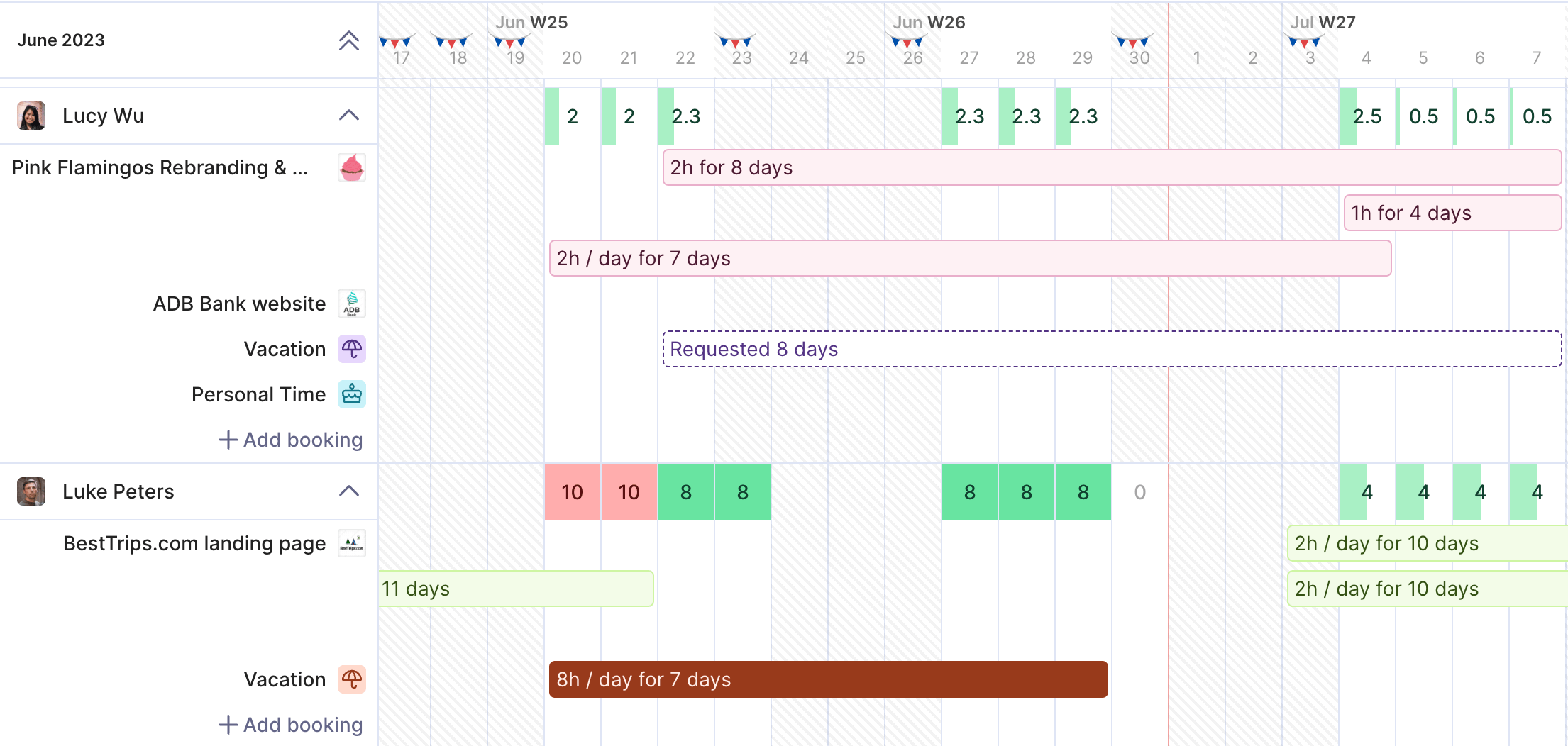
Use Productive to gain complete visibility into team capacity.
How to solve the lack of visibility into team capacity:
Start by centralizing schedules, time logs, and availability in one place so you can see who’s doing what and when. Use capacity planning tools that give you a week-by-week view of your team’s availability across all projects.
In Productive, you can visualize actual team capacity utilization in real time, which makes it easier to shift workloads, delay non-essential tasks, or plan hiring before problems build up.
Manual Processes and Spreadsheets
Manual processes, especially those tied to spreadsheets, slow everything down and make mistakes more likely. Most teams using spreadsheets for task tracking, availability, or approvals find themselves constantly chasing updates or duplicating work across systems.
This slows delivery and introduces errors that could be avoided with proper tooling.
How to get rid of manual processes and spreadsheets:
Start by identifying where your team is still copying data manually or using disconnected tools. Shift those workflows into a central system with built-in automation that connects project updates, approvals, and time logs in one place.
Productive has automated time tracking so that hours are linked to specific projects and budgets without extra steps.
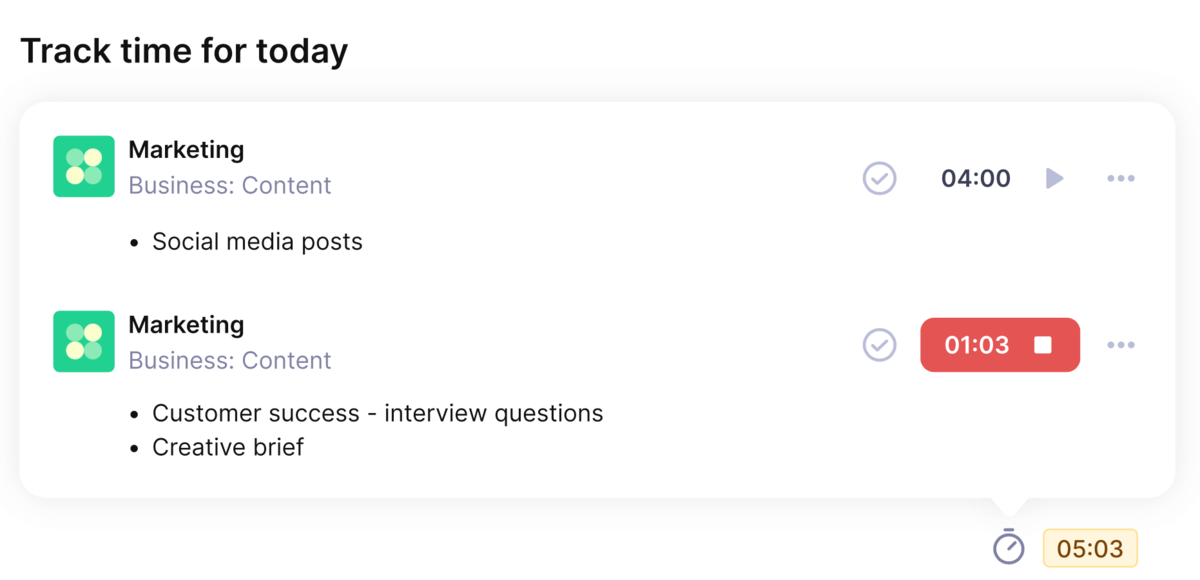
Use Productive’s integrated timers to easily track time (employee hours) on tasks.
Disconnected Systems
Disconnected systems make it hard to track what’s really happening across your projects. When financials, schedules, and task updates live in different tools, the team wastes time switching between systems and trying to reconcile incomplete data.
The result is slow decision-making, missed updates, and a lack of financial visibility into what’s profitable and what’s not.
How to solve disconnected systems:
Start by mapping out all the tools your team uses and identifying where information overlaps or goes missing. Then consolidate as much as possible into a platform that supports integrated resource management, project budgets, and team collaboration in one place.
Productive brings this into a single place where you don’t waste time on manual syncs, plus you get real-time insights.
What Are the Best Practices for Resource Optimization + How To Implement Them?
The best practices for resource optimization are mapping workflows clearly, tracking and improving team utilization, forecasting capacity accurately, integrating financials with resources, and using the right tools to support these steps.
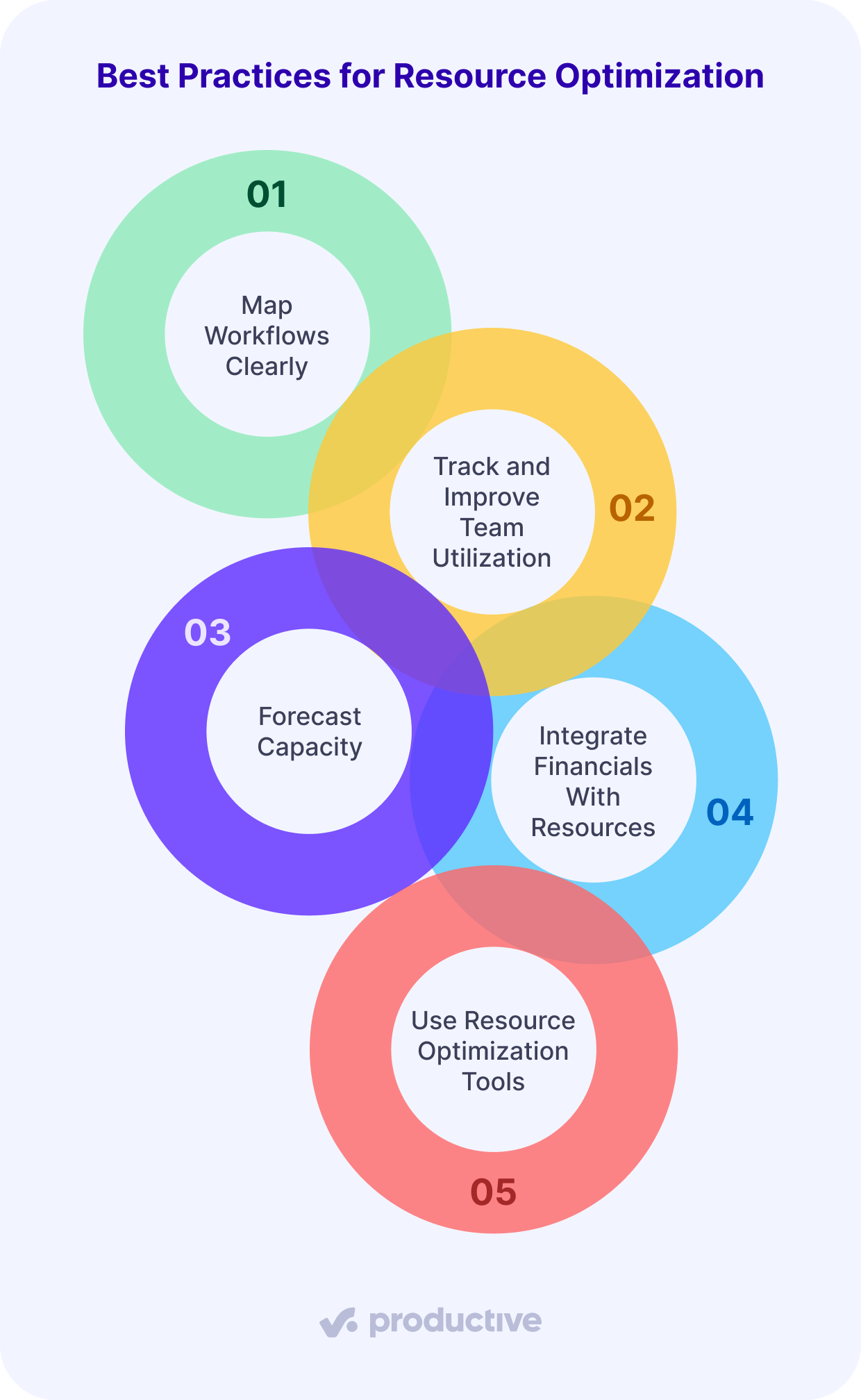
Each of these helps you spot risks earlier and make smarter decisions about where your resources go. Below, we’ll give you more context and teach you how to implement them.
1. Map Workflows Clearly
Mapping workflows clearly means documenting each step of your project process. The impact is higher operational efficiency, because your team spends less time figuring out what to do next and more time actually delivering work.
Clear workflows also make it easier to spot blockers early and avoid duplicate effort.
How to implement workflow mapping:
Start by listing every step in your current delivery process, from client request to final handoff. Then use a visual tool to create a shared flow that everyone can access.
Review it with your team to confirm nothing is missing and adjust as projects evolve. In Productive, you can map workflows directly into Gantt charts or Kanban boards that you can share.
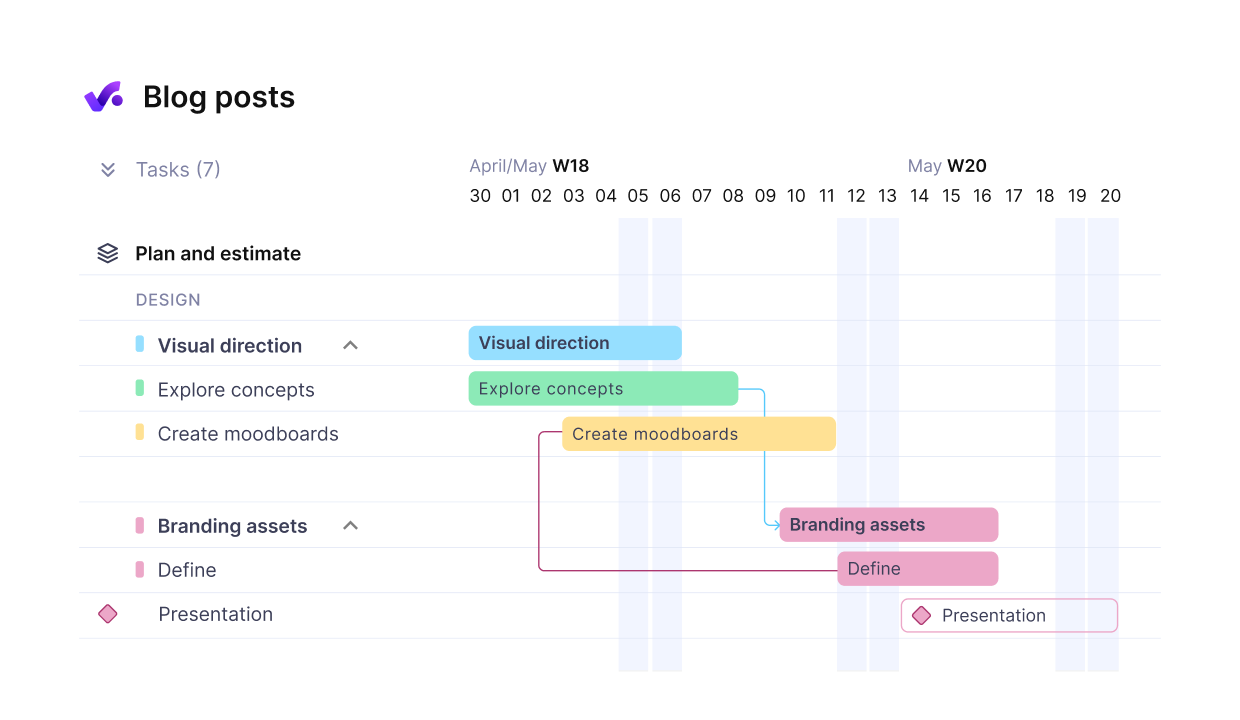
Use Productive to map out workflows with task dependencies.
2. Track and Improve Team Utilization
Track and improve team utilization so that you ensure the right people spend most of their time on billable or high‑value work instead of admin or low‑impact tasks.
This raises profitability and keeps teams happier because work is distributed fairly and everyone contributes where they add the most value.
How to implement tracking and improve team utilization:
Start by measuring how much of each person’s week goes to billable vs. non‑billable work. Review the numbers weekly and reassign low‑value tasks to support staff or automate them where possible.
Then set realistic resource utilization rate targets (for example, 70–80% billable for most roles) and track progress over time. In Productive, you can monitor utilization in real time and spot where adjustments are needed before bottlenecks appear.
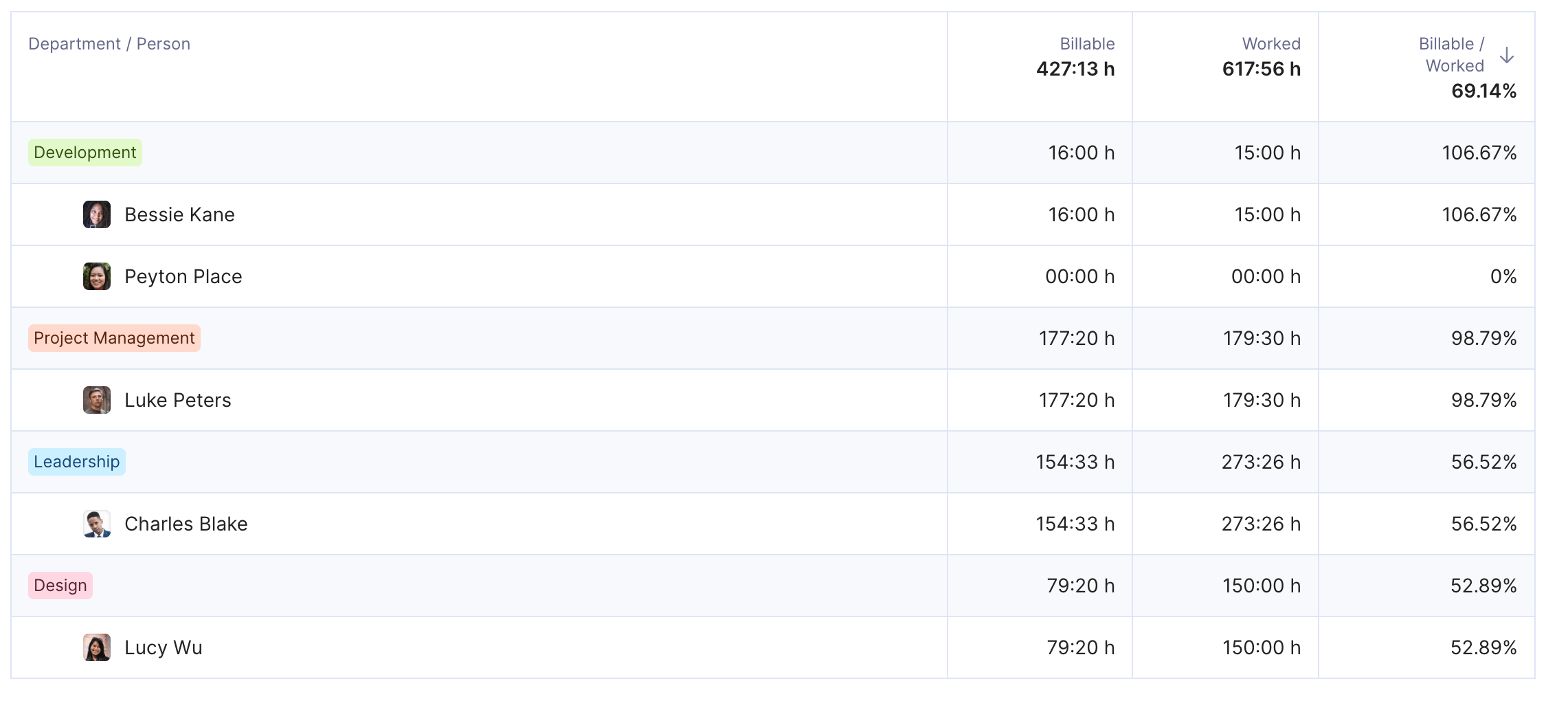
Get a real-time overview of team utilization.
3. Forecast Capacity
Use accurate capacity forecasting to predict future workload based on current commitments and planned projects. This approach helps you ensure that you have enough people to deliver without overloading them.
It reduces last-minute staffing crises and builds confidence in accepting new work because you can see your true capacity ahead of time.
How to implement capacity forecasting:
Review ongoing projects and pipeline opportunities each week, then estimate required hours for each role. Compare that demand with actual availability in your resource plan to see where gaps or overloads will occur.
Adjust hiring plans, shift deadlines, or redistribute work before issues come up.
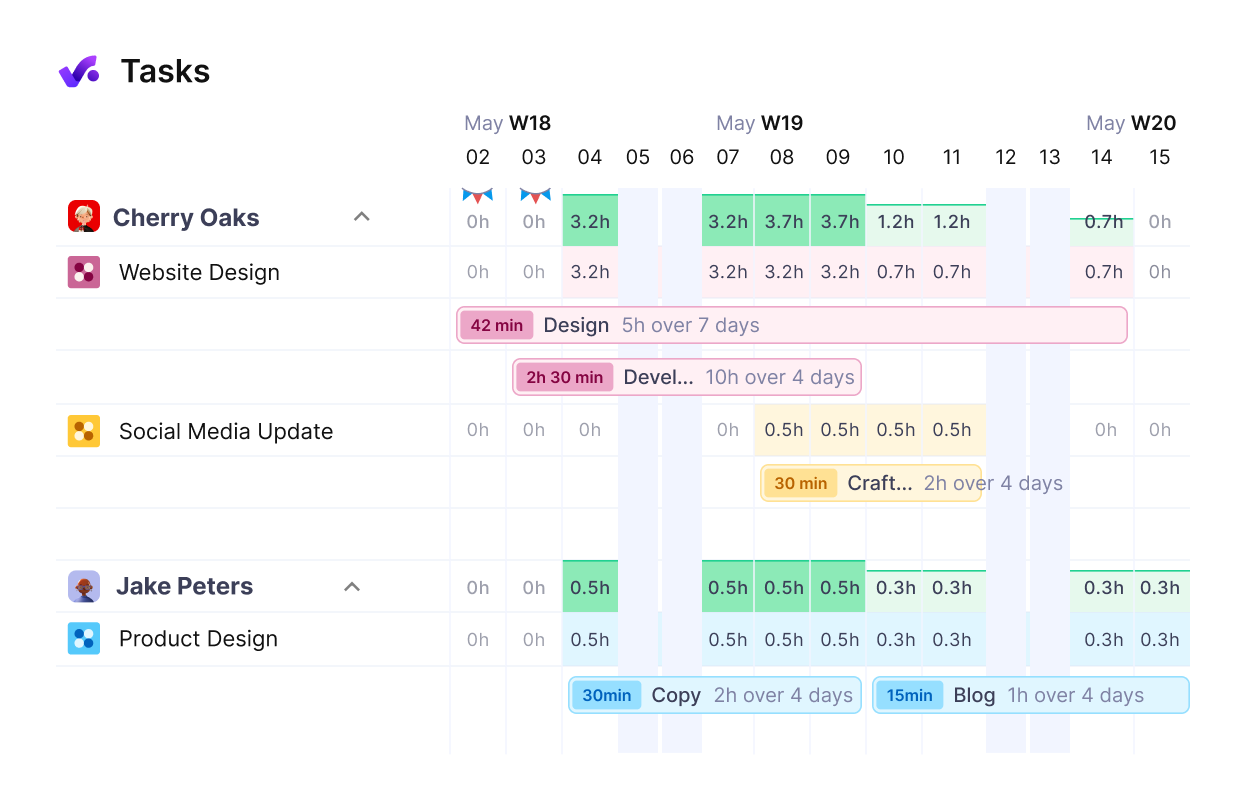
Use Productive to track and forecast your team’s capacity.
4. Integrate Financials With Resources
Integrate financials with resources by connecting budgets and costs directly with how you staff your team. This practice improves resource allocation because you see the cost of every role and task in real-time.
It also protects project profitability and helps you avoid overspending on phases that won’t generate returns.
How to implement integrating financials with resources:
Start by linking each project’s budget to the hours and roles assigned to it. Track planned vs. actual costs weekly and adjust scope, staffing, or timelines as soon as overruns appear.
Use resource management tools that combine budgeting and resource planning in one view. In Productive, you can connect budgets with tasks and team schedules so you see how staffing decisions affect profits.
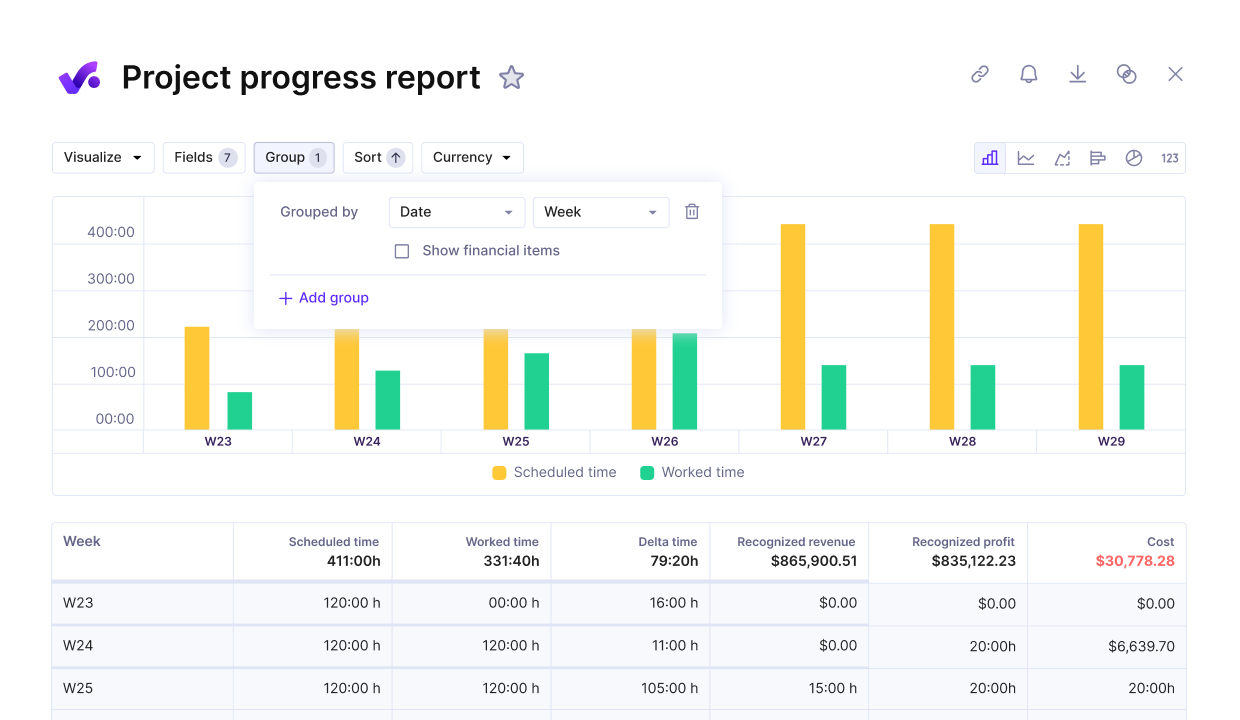
Track progress, time and resource costs in a single real-time view.
5. Use Resource Optimization Tools
Use the right tools for resource optimization to centralize schedules, budgets, and workload planning. These tools cut double entry, prevent missed updates, and give you one source of real-time data. The result is faster decisions and fewer errors.
How to implement resource optimization tools:
List all the tools your team currently uses for scheduling, budgeting, and reporting. Identify overlaps or gaps, then move those project workflows into one integrated platform.
Prioritize tools that offer built-in automation for repetitive tasks like approvals or budget updates, and make sure time tracking connects directly to projects and financials.
Productive is one example that brings these functions into a single system, letting you plan, track, and optimize without switching between apps.
What Are the Best Tools for Resource and Workforce Optimization?
The best tools for resource and workforce optimization are project management and operations platforms that combine capacity planning, resource management, financial visibility, and time tracking in one system.
They let you compare staffing needs with available resources, track costs against budgets, and monitor performance metrics without juggling multiple apps.
Core features your resource management software should include:
- Capacity planning dashboards that show future availability by role or person
- Centralized resource management to assign tasks based on skills and workload
- Real-time financial visibility with budgets tied to staffing plans
- Built-in time tracking linked directly to projects and budgets
- Automation for repetitive updates like approvals, reporting, or budget adjustments
Productive is one of these tools. It combines capacity planning, resource management, financial visibility, and time tracking into a single platform.
In case you need extra options here, we got you covered. There’s a big list of the best resource management software on our blog. You’re welcome.

Use Productive to get an early warning of budget overruns.
What are Great Examples of Optimizing Resources?
Examples of resource optimization would be a consultancy firm improving capacity planning by comparing pipeline demand with current staffing, and a development agency improving workload balancing by centralizing tasks under proper resource management.
Below, we’ll expand with more context and takeaways.
Example 1: Consultancy Firm Improving Capacity Planning
A mid-sized consultancy often struggled to commit to new projects because it had no clear view of the upcoming workload. Senior consultants were frequently overbooked while junior staff had unused hours, which led to missed deadlines and client frustration.
The problem:
They relied on static spreadsheets to track availability, which quickly went out of date and gave managers no reliable picture of actual workload.
The solution:
The firm introduced capacity and resource management software that pulled in both active project data and pipeline opportunities. This gave managers a live view of each consultant’s availability and skills.
They could reassign work more fairly, spread tasks to underused staff, and forecast when to bring in contractors before projects slipped.
What you can learn from this example:
- Replace static spreadsheets with live capacity planning to see real availability.
- Use data from both active projects and pipeline work to make accurate staffing decisions.
- Rebalance workloads between senior and junior staff to improve delivery speed and client satisfaction.
Example 2: Development Agency Improving Workload Balancing
A fast-growing development agency constantly faced delays because its designers were overwhelmed, while developers sometimes waited for work. This mismatch created frustration and led to missed launch deadlines.
The problem:
Each team tracked tasks in separate tools, so no one had a complete view of workloads. Designers took on urgent requests without knowing what was already scheduled, while developers often received tasks too late.
The solution:
The agency centralized task management under one resource management platform. This allowed managers to see the workload of every role in real time and redistribute assignments before bottlenecks formed. By aligning design and development schedules, they reduced overtime and improved delivery speed.
What you can learn from this example:
- Centralize tasks in one place to give everyone a shared view of workloads.
- Use workload balancing to prevent some roles from burning out while others sit idle.
- Align schedules between departments to cut delays and improve delivery consistency.
Final Thoughts
Resource optimization is helps you cut wasted hours, remove bottlenecks, and protect project profitability by making sure time and budget go to work that creates value. However, it can’t be done without the right data and the right tools.
Project management software like Productive helps you hit the right mix of available skills, resources and workflow efficiency. Implement the best practices from this article and you’ll see improvements across resource utilization rates, forecasting, and margins.
Book a short demo and see how Productive can help your team work smarter.
Optimize and Manage Resources with Productive
Get real-time visibility into budgets, utilization, and capacity so projects stay profitable and teams avoid burnout.
